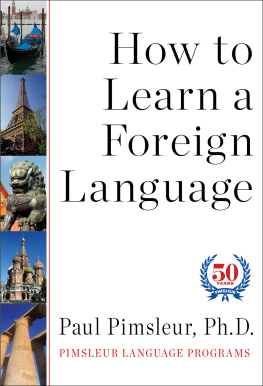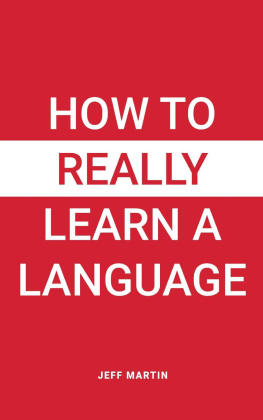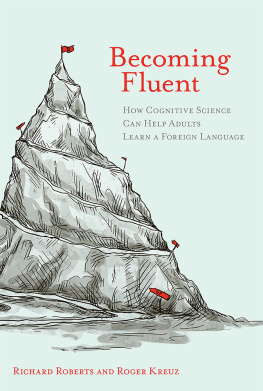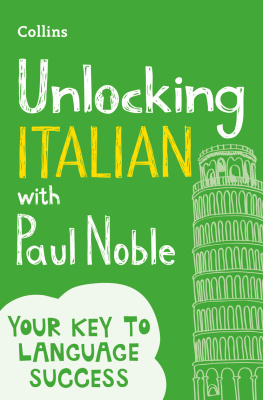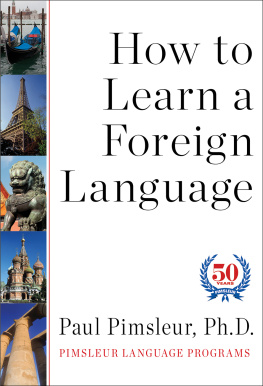Paul Pimsleur - How to Learn a Foreign Language
Here you can read online Paul Pimsleur - How to Learn a Foreign Language full text of the book (entire story) in english for free. Download pdf and epub, get meaning, cover and reviews about this ebook. year: 2013, publisher: Pimsleur, genre: Science. Description of the work, (preface) as well as reviews are available. Best literature library LitArk.com created for fans of good reading and offers a wide selection of genres:
Romance novel
Science fiction
Adventure
Detective
Science
History
Home and family
Prose
Art
Politics
Computer
Non-fiction
Religion
Business
Children
Humor
Choose a favorite category and find really read worthwhile books. Enjoy immersion in the world of imagination, feel the emotions of the characters or learn something new for yourself, make an fascinating discovery.
- Book:How to Learn a Foreign Language
- Author:
- Publisher:Pimsleur
- Genre:
- Year:2013
- Rating:5 / 5
- Favourites:Add to favourites
- Your mark:
- 100
- 1
- 2
- 3
- 4
- 5
How to Learn a Foreign Language: summary, description and annotation
We offer to read an annotation, description, summary or preface (depends on what the author of the book "How to Learn a Foreign Language" wrote himself). If you haven't found the necessary information about the book — write in the comments, we will try to find it.
How to Learn a Foreign Language — read online for free the complete book (whole text) full work
Below is the text of the book, divided by pages. System saving the place of the last page read, allows you to conveniently read the book "How to Learn a Foreign Language" online for free, without having to search again every time where you left off. Put a bookmark, and you can go to the page where you finished reading at any time.
Font size:
Interval:
Bookmark:
For Jean
For me, this is the perfect book on learning a new language.
It is all the things most language learning tools are not. Its direct, full of useful pearls of wisdom that are easily incorporated into ones day-to-day study of a new language. Its clear and well written, and nowhere does academic-speak sneak into the text.
Paul Pimsleurs theories, as expressed in How to Learn a Foreign Language, are deceptively simple. In his own teaching, Dr. Pimsleur saw students repeatedly failing and being turned off of what to him was the most exciting challenge in the world: learning a new language.
This book speaks equally to the different kinds of would-be language learnersfrom those who thought themselves scarred for life by high school Spanish hell to the more confident learners who want to approach the full range of different languages. Youll be surprised at the Foreign Service Institutes (FSIs) grouping of easy to hard languages: what language ranks where isnt entirely obvious.
Paul Pimsleur was very direct in his advice on what to look for in a teacher: when the classroom experience is not going to help you learn and when it is, when youre within your rights to object to your time being wasted by methods that arent going to teach you anything.
A lot of what Ive come to know as the Pimsleur Method is developed from the ground up in this book.
As Pimsleur walks you step-by-step through his straightforward advice on how to learn a language, so he sets out the principles of the Pimsleur Method, answering many of the questions Ive had about the reasoning behind the program. By the end of this short book, youve gotten the benefit of his years of experience and the results of his research that led to defining the behaviors proven to result in your learning a new language more easily.
Im also lucky to be in frequent contact with Dr. Pimsleurs wife, Beverly, and his daughter, Julia, both of whom cheer us on in spreading the word about Pimsleur. As importantly, they each keep Paul Pimsleur from becoming a lifeless statue, constantly providing insights and anecdotes about Pimsleur that enable us to think of him as present in our daily business.
It has been some thirty-seven years since Paul Pimsleur died of a heart attack while he was teaching at the Sorbonne in Paris. His wife, Beverly Pimsleur, brought the manuscript of this book to Charles Heinle, the original publisher, and he published it in 1980. It was Charless wife, Beverly Heinle, Pimsleur Language Programs editor-in-chief, who suggested we republish it as part of our fiftieth anniversary celebration in 2013.
The statistics and other reference materials are more than thirty years old, but they remain directionally correctthe underlying point would be the same if they were all translated to 2013 values.
I only wish this edition could reflect what Dr. Pimsleur would have done with all of the new technology that has emerged in the ensuing thirty years. He was always in the forefront: in the 1960s he was responsible for developing the first computerized language laboratory at Ohio State University, where he set up a venture with Ohio Bell Telephone Company that enabled students to learn at their own pace, dialing in directly to hear preprogrammed tapes. I cant help but think hed admire the revolutionary Course Manager App weve developed.
To celebrate the fiftieth anniversary of the Pimsleur programs, we are republishing Paul Pimsleurs original How to Learn a Foreign Language . It is astonishing how it has stood the test of time.
The mechanical delivery systems have changed: for cassettes, records, and tape recorders, you can now read in CDs and downloads. The political alignments in , The Twelve Most Widely Spoken Languages, has increased, and the ranking order of the languages fluctuates, but they are still the most widely spoken.
And all the rest holds true: Pauls wisdom is as valuable today as it was when it was originally published.
Robert Paris Riger
Pimsleur Language Programs
Paul Pimsleur (October 17, 1927June 22, 1976) was a scholar in the field of applied linguistics. He developed the Pimsleur language learning system, which, along with his many publications, had a significant effect on theories of language learning and teaching.
Paul Pimsleur was born in New York City and grew up in the Bronx. His father, Solomon Pimsleur, was from France and a composer of music; his American-born mother was a librarian at Columbia University.
Dr. Pimsleur earned a bachelors degree at the City College of New York; he received a masters degree in psychological statistics and a Ph.D. in French, both from Columbia University.
He first taught French phonetics and phonemics at the University of California, Los Angeles. After leaving UCLA, Pimsleur went on to a faculty position at Ohio State University, where he taught French and foreign language education. At the time, the foreign language education program at OSU was the major doctoral program in the field in the United States. While there, he created and directed the Listening Center, one of the largest language laboratories in the United States. The center was developed in conjunction with Ohio Bell Telephone and allowed self-paced language study using a series of automated tapes and prompts that were delivered over the telephone.
Dr. Pimsleur, along with a number of renowned linguists and experts in the field of language teaching, was called to Washington, D.C., in 1962 for a discussion on what could be done to improve foreign-language teaching in the United States. Math and science were not the only areas that had been found wanting when the U.S. education system was examined in the wake of Sputnik and the Soviets winning the race to space.
Dr. Pimsleur proposed creating a self-study audio language program based on his own classroom methodology and his experience with students at the Listening Center. In order to be able to judge the effectiveness of his approach, he was asked to choose a language not familiar to most English speakers. He chose Greek, which also had the advantage of added difficulty because of a non-Latin alphabet.
Pimsleur and his wife, Beverly (who served as his researcher as he produced and recorded the course), went to Greece in March 1962. They returned in August of that year, and the first Pimsleur course, Speak & Read Essential Greek: A Tapeway Program, was self-published in March 1963. The subsequent languages undertaken by Dr. Pimsleur were French (1964), Spanish (1966), German (1967), and Twi (1971).
Later, Pimsleur was a professor of education and romance languages at the State University of New York in Albany, where he held dual professorships in education and French. He was a Fulbright lecturer at the Ruprecht Karls University of Heidelberg in 1968 and 1969 and a founding member of the American Council on the Teaching of Foreign Languages (ACTFL). He did research on the psychology of language learning, and in 1969 was the section head of psychology of second languages learning at the International Congress of Applied Linguistics.
His research focused on understanding the language acquisition process, especially the learning process of children, who speak a language without knowing its formal structure. The result of this research was the Pimsleur language learning system.
Through this research, he identified three factors that could be measured to calculate language aptitude: verbal intelligence, auditory ability, and motivation. He was one of the first foreign language educators to show an interest in students who have difficulty in learning a foreign language while doing well in other subjects.
After Dr. Pimsleurs death, the ACTFL-MLJ Paul Pimsleur Award for Research in Foreign Language Education was created and is awarded annually.
Font size:
Interval:
Bookmark:
Similar books «How to Learn a Foreign Language»
Look at similar books to How to Learn a Foreign Language. We have selected literature similar in name and meaning in the hope of providing readers with more options to find new, interesting, not yet read works.
Discussion, reviews of the book How to Learn a Foreign Language and just readers' own opinions. Leave your comments, write what you think about the work, its meaning or the main characters. Specify what exactly you liked and what you didn't like, and why you think so.

